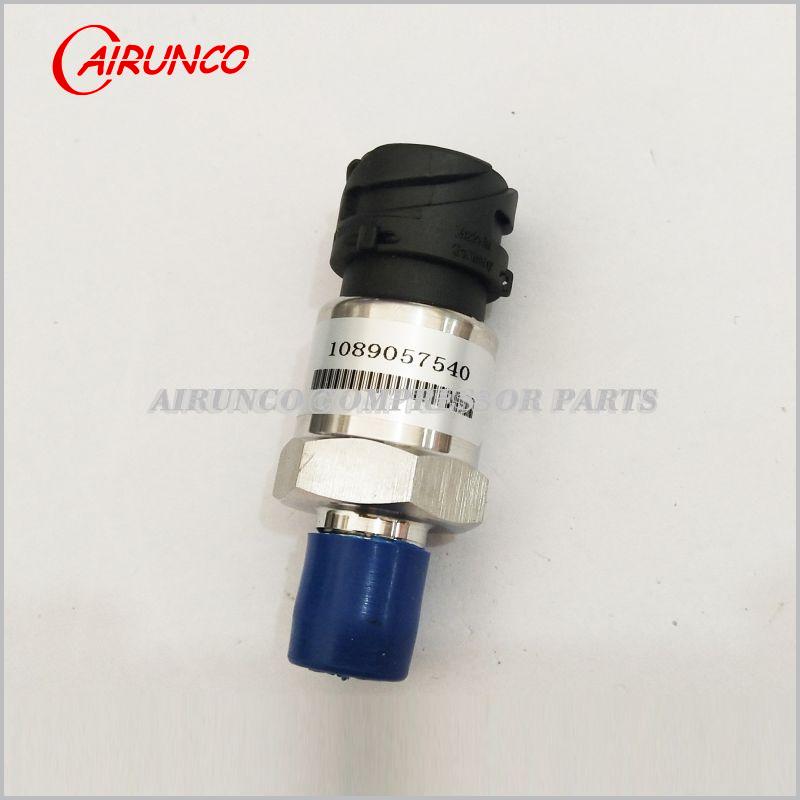Transducer 1089057540 Pressure Sensor Air Compressor Parts 1089-0575-40
Air compressors are divided into reciprocating compressors and screw compressors according to their working principles. The accessories of air compressors mainly include some conventional vulnerable parts. The accessories of screw compressors are divided into vulnerable parts, such as temperature sensors, pressure sensors, computer boards, relay boards, PLC controllers, control panels, operation panels, solenoid valves, rotary valves, pneumatic valves, blow-off valves, temperature control valves, thermal control valves, temperature control valve cores, proportional valves, capacity control valves, pressure maintenance valves, inlet valves, safety valves, regulating valves, switches, ducts, starter plate buffers, and so on. Unlike reciprocating compressors, screw compressors operate differently and have different designs. Vulnerable parts of screw compressors include oil filters, air filters, oil-gas separators, machine oils, and so on.
Air Compressor Spare parts Accessory Classification:
Sensors: Temperature sensor, Pressure sensor.
Controllers: Computer board, Relay board, PLC controller, Controller, Control panel, Operation panel.
Valves: Solenoid valve, Rotary valve, Pneumatic valve, Blow-off valve, Temperature control valve, Thermal control valve, Temperature control valve core, Proportional valve, Capacity control valve, Pressure maintenance valve, Inlet valve, Safety valve, Regulating valve, Expansion valve, Check valve, Shuttle valve, Pipeline filter, Automatic drain valve, Water filter cup, Pressure relief valve, Pressure regulator.
Filters and Oil: Air filter, Oil filter, Oil separator, Lubricating oil, Pipeline filter, Automatic drain valve, Water filter cup.
Main Unit: Main unit (compressor head), Bearings, Shaft seals, Bushings, Gears, Gear shafts, Overhaul kits.
Maintenance Kits: Main unit, Unloader valve maintenance kit, Pressure maintenance valve, Rotary valve, Temperature control valve core, Inlet valve, Coupling elastomers, etc.
Cooling: Fan, Radiator, Heat exchanger, Oil cooler, Aftercooler.
Switches: Pressure switch, Temperature switch, Emergency stop switch, Pressure differential switch.
Transmission: Coupling, Elastomers, Spider couplings, Elastic blocks, Gears, Gear shafts.
Hoses: Inlet hose, High-pressure hose.
Starter Plate: Contactor, Thermal protector, Reverse-phase protector, Terminal block, Relay, Transformer, etc.
Buffers: Shock absorber pad, Expansion joint, Expansion valve, Elastomers, Spider couplings, Elastic blocks.
Instruments: Timer, Temperature switch, Temperature indicator, Pressure gauge, Pressure regulator.
Motors: Permanent magnet motor, Variable frequency motor, Electric motor.
Maintenance and Replacement of Air Compressor:
The quality of screw compressor oil has a decisive impact on the performance of oil-injected screw compressors. Good-quality oil should possess properties such as excellent oxidation stability, rapid separation, good foam control, high viscosity, and corrosion resistance. Therefore, users must use dedicated screw compressor oil.
During the break-in period, the oil should be changed after 500 hours of operation, and thereafter, the oil should be replaced every 2000 hours of operation. It is advisable to replace the oil filter when changing the oil. In harsh environmental conditions, the replacement cycle should be shortened.
Replacement Method:
Start the air compressor and run it for 5 minutes to raise the oil temperature to above 50°C, reducing the oil viscosity.
Stop the operation. When there is pressure of 0.1 MPa in the oil-gas barrel, open the drain valve at the bottom of the oil-gas barrel and connect a storage tank to it. The drain valve should be opened slowly to prevent hot oil from splashing and causing injury or contamination. Close the drain valve after the lubricating oil drips out.
Unscrew the oil filter and drain the lubricating oil from all pipelines. Replace the oil filter with a new one.
Open the oil filling port plug, pour in the new oil until the oil level reaches the specified mark, tighten the oil filling port plug, and check for any leaks.
The lubricating oil should be checked regularly during use. If the oil level is too low, new oil should be added promptly. Condensate water must also be drained regularly. Under normal circumstances, it should be drained once a week, and in hot climates, it should be drained every 2-3 days. If the compressor has been stopped for more than 4 hours and there is no pressure in the oil-gas barrel, open the drain valve to drain the condensate water. Quickly close the valve when oil flows out.
Mixing lubricating oils of different brands is strictly prohibited, and it is essential to avoid using expired lubricating oil. Otherwise, the quality of the lubricating oil will deteriorate, resulting in poor lubrication, lower flash point, and a high risk of oil self-ignition leading to high-temperature shutdowns.


















